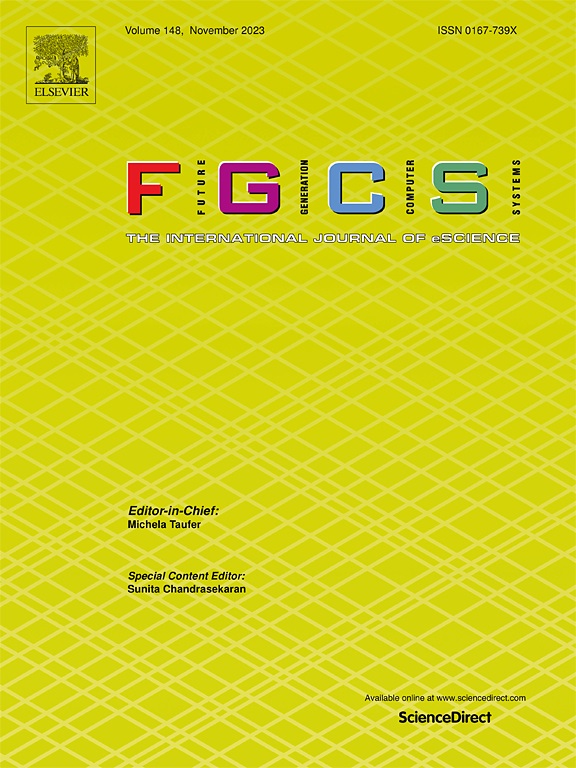A priority-aware dynamic scheduling algorithm for ensuring data freshness in 5G networks
IF 6.2
2区 计算机科学
Q1 COMPUTER SCIENCE, THEORY & METHODS
Future Generation Computer Systems-The International Journal of Escience
Pub Date : 2024-09-26
DOI:10.1016/j.future.2024.107542
引用次数: 0
Abstract
To ensure the freshness of information in wireless communication systems, a new performance metric named the age of information (AoI) is being adopted in the design of transmission schedulers. However, most AoI schedulers rely on iterative optimization methods, which struggle to adapt to real-time changes, particularly in real-world 5G deployment scenarios, where network conditions are highly dynamic. In addition, they neglect the impact of consecutive AoI deadline violations, which result in prolonged information deficits. To address these limitations, we present a 5G scheduler that can cope with dynamic network conditions, with the aim of minimizing the long-term average AoI under deadline constraints. Specifically, we consider a dense urban massive machine-type communication (mMTC) scenario in which numerous Internet of Things (IoT) devices frequently join or leave the network under time-varying channel conditions. To facilitate real-time adaptation, we develop a per-slot scheduling method that makes locally optimal decisions for each slot without requiring extensive iterations. In addition, we combine the per-slot scheduling method with a priority-rule scheduling algorithm to satisfy the stringent timing requirements of 5G. The simulation results show that the proposed scheduler reduces the average AoI by 10%, deadline violation rate by 40%, and consecutive violation rate by 20% approximately compared with other AoI schedulers.
确保 5G 网络数据新鲜度的优先级感知动态调度算法
为了确保无线通信系统中信息的新鲜度,一种名为信息年龄(AoI)的新性能指标正被应用于传输调度器的设计中。然而,大多数 AoI 调度器都依赖于迭代优化方法,很难适应实时变化,特别是在现实世界的 5G 部署场景中,网络条件是高度动态的。此外,它们还忽视了连续违反 AoI 截止日期的影响,这将导致长时间的信息缺失。为了解决这些局限性,我们提出了一种能应对动态网络条件的 5G 调度器,目的是在截止日期限制下最大限度地减少长期平均 AoI。具体来说,我们考虑了密集的城市海量机器型通信(mMTC)场景,在这种场景中,众多物联网(IoT)设备在时变信道条件下频繁加入或离开网络。为促进实时适应,我们开发了一种按时隙调度的方法,该方法可为每个时隙做出局部最优决策,而无需大量迭代。此外,我们还将每个时隙调度方法与优先级规则调度算法相结合,以满足 5G 严格的时序要求。仿真结果表明,与其他 AoI 调度器相比,所提出的调度器可将平均 AoI 降低 10%,截止日期违规率降低 40%,连续违规率降低 20%。
本文章由计算机程序翻译,如有差异,请以英文原文为准。
求助全文
约1分钟内获得全文
求助全文
来源期刊
CiteScore
19.90
自引率
2.70%
发文量
376
审稿时长
10.6 months
期刊介绍:
Computing infrastructures and systems are constantly evolving, resulting in increasingly complex and collaborative scientific applications. To cope with these advancements, there is a growing need for collaborative tools that can effectively map, control, and execute these applications.
Furthermore, with the explosion of Big Data, there is a requirement for innovative methods and infrastructures to collect, analyze, and derive meaningful insights from the vast amount of data generated. This necessitates the integration of computational and storage capabilities, databases, sensors, and human collaboration.
Future Generation Computer Systems aims to pioneer advancements in distributed systems, collaborative environments, high-performance computing, and Big Data analytics. It strives to stay at the forefront of developments in grids, clouds, and the Internet of Things (IoT) to effectively address the challenges posed by these wide-area, fully distributed sensing and computing systems.

 求助内容:
求助内容: 应助结果提醒方式:
应助结果提醒方式:


